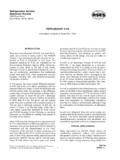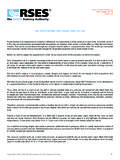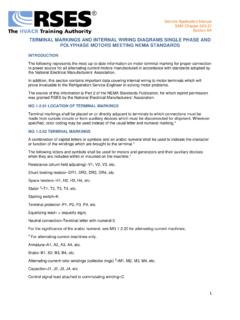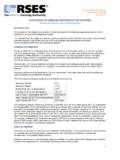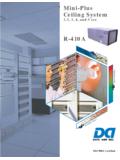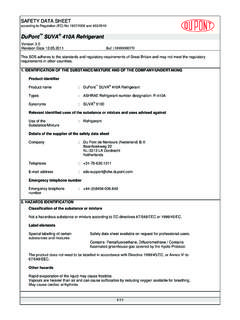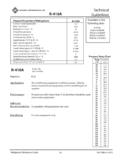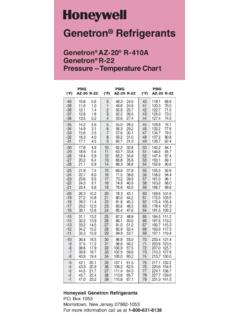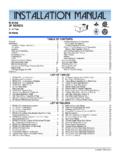Transcription of REFRIGERANT 410A - RSES.org
1 INTRODUCTIONR ecently a new REFRIGERANT , R- 410a , has been formu-lated and currently is being used in the HVAC/Rindustry. It was developed primarily because the pro-duction of R-22 is scheduled to stop soon. Thephaseout schedule for R-22, as mandated by theEnvironmental Protection Agency (EPA), will be dis-cussed in more detail at the end of this R- 410a is specifically intended for use innew air conditioning applications that traditionallywould have used R-22, other applications are alsopossible, including low- and medium-temperaturerefrigeration first glance, the most notable difference betweenR- 410a and R-22 is the higher operating pressures(approximately 50% higher on both the discharge sideandthe suction side).
2 For example, a high-efficiencycondensing unit using R-22 typically operates with asuction pressure of about 68 psi and a dischargepressure of about 250 psi at an outdoor temperatureof 95 F. With R- 410a , the same unit will operateunder the same conditions with a suction pressure of118 psi and a discharge pressure of 400 psi, asshown in Figure 1 on the next page. (Note that inmost cases, equipment designed for R-22 cannotuse R- 410a because of this difference in operatingpressures, so retrofitting an existing R-22 system isnormally not an option.)
3 When R-22 was first introduced as a replacement forR-12 in residential air conditioning applications, man-ufacturers and service technicians had to familiarizethemselves with the characteristics of this new REFRIGERANT . (R-22 operated at higher pressures andwas more efficient than R-12, but did not return oil aswell.) In time, R-22 became widely used and now hasserved the HVAC/R industry well for over 50 R- 410a (which has had to pass strict safetyguidelines that R-12 and R-22 did not have to pass)is becoming more popular, both because it is an HFC(hydrofluorocarbon)
4 , and because its greater effi-ciency allows for the design and use of smaller airconditioning is an azeotropic mixture of HFC-32 has been developed as a long-termreplacement for R-22 in a variety of new air condi-tioning and cooling is an HCFC, orhydrochlorofluorocarbon, which means that it con-tains chlorine, an element that is damaging to theozone layer. Because R- 410a contains no chlorineat all, its ozone depletion potential (ODP) is comes in rose-colored cylinders. The rose color is PMS (Pantone Matching System) is expected to find widespread use in comingyears.
5 Its benefits include significantly higher coolingcapacities and pressures. At 77 F, its density is 50%greater than that of R-22, and its vapor pressure is58% greater. Other advantages include a low toxicitylevel, and recognition by Underwriters Laboratory(UL) that it is virtually nonflammable (although it maybe combustible at elevated pressures, as discussedlater).As with any REFRIGERANT , there are certain safety pre-cautions that the technician needs to understand andobserve. This article describes typical applications,recycling/recovery procedures and equipment, andprecautions applicable to this new REFRIGERANT APPLICATIONSM ajor applications for R- 410a include unitary airconditioning equipment, chillers, and commercialrefrigeration systems.
6 In new unitary residential andlight commercial systems, R- 410a has demonstrateda 5 to 6% higher energy efficiency rating (EER) than1 Refrigeration ServiceEngineers Society1666 Rand RoadDes Plaines, Illinois 60016 REFRIGERANT 410 AInformation compiled by Frank Prah, CMS 2001 by the Refrigeration Service Engineers Society, Des Plaines, ILSupplement to the Refrigeration Service Engineers 3 lR-22. Its higher cooling capacity permits smaller,more compact units to be of the significantly higher pressures associ-ated with R- 410a , a typical compressor designed forR-22 cannot be used with R- 410a .
7 As noted previ-ously, this fact along with other components in thesystem that would need to be changed renders therefrigerant inappropriate for retrofit of existing important issue is the compatibility of thecompressor lubricant with the azeotropic R-410 Amixture. To ensure satisfactory operation and durabil-ity, a polyolester-based lubricant that is miscible withthe REFRIGERANT is recommended. Compressor manu-facturers are continuing to test and recommend spe-cific lubricants for use with R- 410a . It is thereforeimportant to contact the compressor and/or equip-ment manufacturer to reviewsystem lubricantrequirements.
8 It is also important to review materialswith which the REFRIGERANT will come in contact, includ-ing motor windings in hermetic and semi-hermeticcompressors, gaskets, etc., for and R-22 are chemically compatible whichmeans that they will not react or form other com-pounds if accidentally mixed but they will formamixture that can be difficult to separate. At this time,separation cannot be accomplished by any knownon-site recovery device or in the facilities of most off-site reclaimers. Disposal of the mixture by incinerationis OF R-410 AThe capability and compatibility of recovery andreclamation equipment are equally important consid-erations for the service technician.
9 Despite R- 410a snegligible impact on the ozone, reclamation andrecycling are mandatory, and disposal must be con-ducted in accordance with national, state or provin-cial, and local and foremost, R- 410a s higher vapor pressuresmean that careful attention must be paid to thedesign pressure rating of handling and storageequipment, including recovery and storage R- 410a , a working pressure capability of at least400 psi is recommended (this includes recoverycylinders).Standard DOT recovery cylinders rated for350 psi should notbe onlyDOT recoverycylinders rated for 400 psi or higher when of the recovery equipment with thecomponents that make up R- 410a also is to the guidelines provided by the manufac-turer of the REFRIGERANT , make sure you consult thecompatibility data supplied by the recovery equip-ment precautions are required during storage andhandling.
10 An important handling practice is the use ofliquid charging(rather than vapor charging) to mini-mize compositional changes. Refrigerants in the -400and -500 ASHRAE classification series should be2R-2268 psi250 psiR-410A118 psi400 psiFigure 1. Typical operating pressurescharged (put into the system) in a liquid state. Not allmanufacturers equip their cylinders with dip a dip tube, the cylinder must be in theinverted position (turned upside down) for liquidcharging. If you are charging on the high side, refrig-erant can enter the system as a liquid, since there isno danger of the REFRIGERANT reaching the compressorin liquid form and causing slugging damage.
